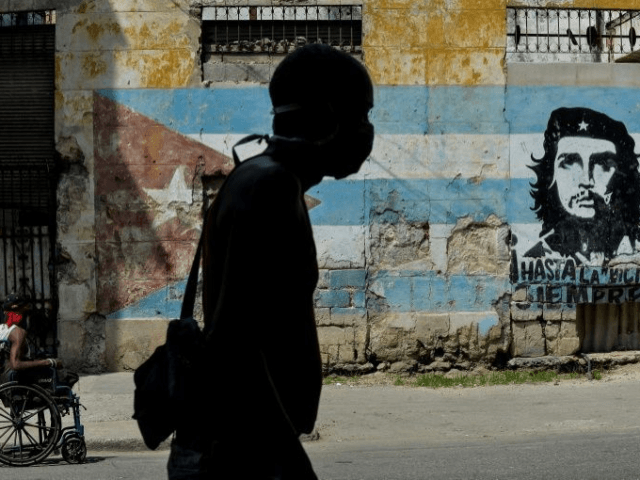A shocking video caught the moment on Monday in which Havana residents fled a large cloud of debris created by a collapsing building, which locals alleged had been under “demolition” orders for years.
The communist Cuban government has invested almost no resources into basic infrastructure nationwide, but especially in Havana, throughout the last six decades of its rule, instead spending on comforts for the elites and building lavish resorts that Cuban citizens were banned from for decades. As a result, much like Cuba’s famed dilapidated cars, the buildings Havana residents live in are slowly disintegrating. The collapse on Monday is the third to garner international headlines in the city this year, the deadliest of which occurred in January and killed three girls.
Images that surfaced online, Diario de Cuba reported on Tuesday, were initially uploaded to social media with photos by local Rosa Villavicencio. Miami-based Cuban journalist Yusnaby Pérez posted a video of the incident online, with the caption “these are not scenes from the apocalypse, these are people fleeing to save their lives in Cuba after another residential building collapse #socialism.”
No son escenas de una película del Apocalipsis, son personas corriendo para salvar sus vidas en #Cuba luego de que se desplomara otro edificio familiar. #Socialismo pic.twitter.com/3I9Y0I1QMo
— Yusnaby Pérez (@Yusnaby) June 9, 2020
Pérez later published a video that showed the delicate state of what was left of the building, apparently recorded on Tuesday. Locals in the video say the building had been condemned for years, and the government was supposed to demolish it. A local resident in the video told the cameraman that no one had lived in the building for over five years, but that the regime had failed to promptly deal with its remains. The building appeared hollowed out and covered only with torn fabric in the video.
“They took down a large piece of it yesterday and that is what created the cloud [of debris],” another man, identified as the source who sent the video to Pérez, said. Heavy rains reportedly contributed to the intensity of the collapse. There are currently no known injuries that resulted from the incident.
The collapse recalled similar incidents that have generated alarm in Havana in the past year. In March, 26-year-old Rolando Mulen Rodríguez died after a pillar in a residential building he was working to repair collapsed; at least one other person, a teenage male, was injured. The two were reportedly attempting makeshift repairs to restore some balance to the building after they failed to get the attention of the communist government to come and use professional equipment to prevent a collapse. The incident occurred in Old Havana.
“You can go to Housing [the Cuban government’s housing agency], complain about whatever danger of collapse situation in your home, the first thing they tell you is that they have more than a thousand ‘miraculous statics’ and that one has to be patient,” a neighbor, Aníbal Rodríguez, Vázquez, told Cubanet. “Miraculous static” is an allegedly supernatural force that keeps Cuban buildings from collapsing, according to the government.
In January, the collapse of a balcony, also in Old Havana, resulted in the death of three girls: María Karla Fuentes and Lisnavy Valdés Rodríguez, both 12 years old, and Rocío García Nápoles, age 11. The balcony belonged to an abandoned, dangerously deteriorated building located across the street from a school. The girls were reportedly near the building while practicing for a school recital on Cuban founding father José Martí.
Locals told the Miami-based Martí news agency that the building, while derelict, was not labeled as such or cordoned off in any way. Prior to the collapse, local residents had begun an attempt to slowly take down the most dangerous parts of the building after months of trying to get the attention of Cuban government authorities. The attempt to take it down may have resulted in the collapse of the balcony.
Cuban government agents claimed they were aware of the perilous status of the building and working on removing the threat.
2020 has proven a particularly difficult year for Cubans, who are now also facing the threat of the Chinese coronavirus, which the regime allowed to spread by promoting tourism in March, at the height of the pandemic. Italian tourists are believed to have brought the virus to the island, though Cuba also allowed a cruise ship to dock in the country that had been isolated as a result of coronavirus cases on board.
After a national uproar, the Cuban government eventually canceled its plans to promote tourism to the island when the rest of the world limited travel and began limiting travel itself. At home, Cubans attempted to sew homemade sanitary masks and keep a distance, but being forced onto hours-long ration lines for basic foods and other goods resulted in large crowds gathering outside markets in cities, often with no supervision or guidance on social distancing.
Cuban dissidents have also complained that the regime is using “social distancing” to hinder their ability to engage with the rest of society.
“The government has taken advantage of Covid-19 [Chinese coronavirus] to convert our houses into prisons,” Cuban activist and artist Amaury Pacheco told Diario de Cuba in May. “I understand that there are many measures that are important, but a government that takes advantage of and treats all citizens as criminals … It detains activists, people who are against obscure decrees that go against freedom of expression.”

COMMENTS
Please let us know if you're having issues with commenting.